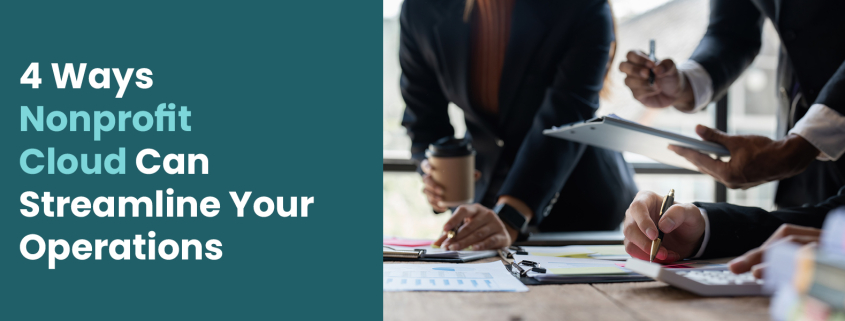4 Ways Nonprofit Cloud Can Streamline Your Operations
In 2022, 77% of nonprofits indicated that technology aids their organizations in various critical areas, namely driving efficiency and impact. But, less than half of these organizations can quickly extrapolate insights from data to make data-backed decisions.
Given this disparity between the perceived and actual benefits that technology and data hold for nonprofits, it’s clear that these tools and the way nonprofits use them need to be optimized.
Nonprofit Cloud consolidates top features from various industry clouds into a single, unified platform. This scalable solution grows with nonprofits, provides access to more tools than the Nonprofit Success Pack, and simplifies workflows.
In this guide, we’ll discuss how Nonprofit Cloud drives efficiency, empowering nonprofits to focus on mission-critical activities.
1. Creates a single, unified system.
Salesforce products bring all the tools your nonprofit needs together, creating one integrated system. As Fíonta’s Nonprofit Cloud explainer highlights, the system is built on Salesforce core and offers customizable applications for case and program management, fundraising and donor management, and more.
With these offerings housed on a single platform, nonprofits can streamline workflows and seamlessly manage data. The top benefits of using this integrated solution include:
- Eliminating data silos. Data silos occur when information is stored across multiple, disconnected systems. Nonprofit Cloud seamlessly integrates with other Salesforce Clouds and tools, ensuring the data in your CRM is complete and up-to-date. Nonprofits can integrate their websites with Salesforce to streamline data flow between systems and improve user experiences. For example, if your nonprofit sells a limited number of tickets to a fundraising gala, the integration makes it possible to show users how many tickets remain in real-time.
- Increasing collaboration across teams. Centralizing data ensures that all teams can access consistent, updated information from various sources. For example, a development team can access volunteer records to identify prospective donors without requesting access to the records from the volunteer director. Role-based access controls can also be used to protect sensitive data if needed.
- Providing a comprehensive view of constituents. Constituent data collected from various sources, such as donation forms, program records, and volunteer management tools, is stored in one easily accessible location with Nonprofit Cloud. Constituent profiles are created and updated using these many data points. Nonprofits can leverage these comprehensive profiles to personalize communications, better assist beneficiaries, and recommend volunteer opportunities.
Streamlining administrative tasks, like manually transferring data between systems, saves nonprofits valuable time and money. Through technology integrations and automation, your staff members can reallocate their time toward mission-critical tasks instead.
2. Allows for intensive customization.
Nonprofit Cloud is highly adaptable. Nonprofits have access to the initial set of tools included in Nonprofit Cloud and the option to leverage other Salesforce apps and integrations.
Specific ways to customize Nonprofit Cloud for your nonprofit’s needs include:
- Utilizing integrations. Having disconnected platforms or workarounds wastes time and yields outdated or inaccurate data. Salesforce offers thousands of integrations that connect other systems to your CRM instance, ensuring data and workflows move seamlessly from one to the other.
- Adding other Salesforce Clouds. Easily add the features included in other Salesforce Clouds to your nonprofit’s CRM. For example, streamline and improve marketing efforts by leveraging Marketing Cloud to build omnichannel pathways that guide supporters to take action.
- Establishing custom workflow rules. Build custom workflows that align with your organization’s specific needs and programs. Automate tasks, notifications, and other follow-up actions based on triggers or conditions relevant to your nonprofit. For example, an organization with a volunteer-based mentoring program can automate the match process, with the trigger being new enrollments.
These customizations save nonprofits valuable time and resources by automating administrative tasks, streamlining collaboration between teams, and providing the tools needed to accomplish mission-critical tasks.
3. Offers robust analytics and reporting tools.
Understanding donors is the key to nonprofit growth and success. GivingDNA explains that data analysis should reveal trends and insights that effectively guide fundraising strategies. However, deriving meaningful insights from donor databases is a pain point across many organizations.
Salesforce offers pre-built reports and dashboards designed for nonprofits. Some of the reports provided include:
- LYBUNT (Last Year But Unfortunately Not This Year): Understand which donors gave in the past and send them targeted appeals for the current year.
- Memberships: For nonprofits with membership programs, easily visualize membership data such as join date, growth over time, and more.
- Projection report: View an estimate of your cash flow over the next year. Add percentage changes (e.g., a 10% increase in revenue) to understand how initiatives may impact cash flow.
These reports can be customized to fit specific nonprofit needs and initiatives. Alternatively, organizations can build them from scratch to suit unique or complex campaign tracking and reporting needs.
4. Grows with your nonprofit with flexible and scalable features.
Nonprofit Cloud eliminates the need for future upgrades and implementation of new software. Instead, organizations can easily configure the system and manage integrations with other solutions on the AppExchange to align with changing needs.
Additionally, Nonprofit Cloud can accommodate your nonprofit’s growth. While some CRMs limit the number of records users can add, Nonprofit Cloud uses a cloud-based system that enables organizations to add records continuously.
Similarly, the system can adapt to employee growth. Charitable organizations receive 10 free licenses annually to Salesforce, improving your nonprofit’s ability to collaborate across teams and use the system simultaneously. Nonprofits have the option to add more user seats as needed.
Investing in Nonprofit Cloud will allow your nonprofit to work more efficiently, encourage team collaboration, and simplify data collection. Additionally, the scalable system grows with your nonprofit. Having everything your organization needs to operate on one, unified platform will provide a better experience for donors, volunteers, and beneficiaries.
